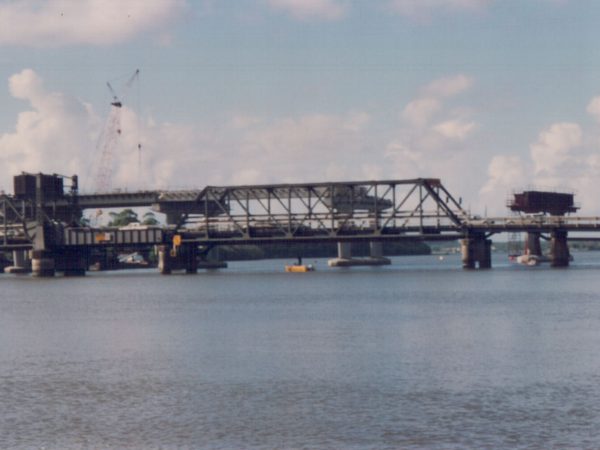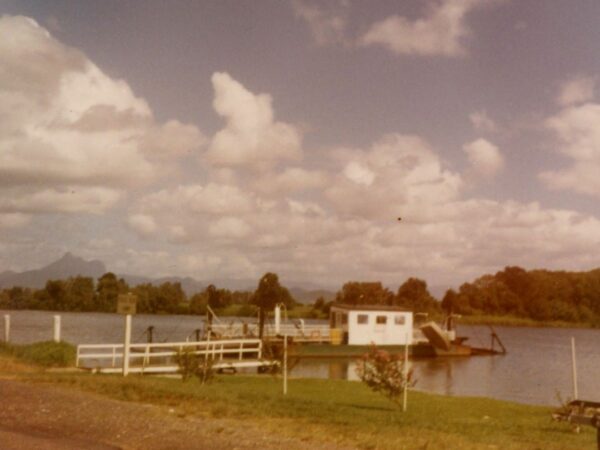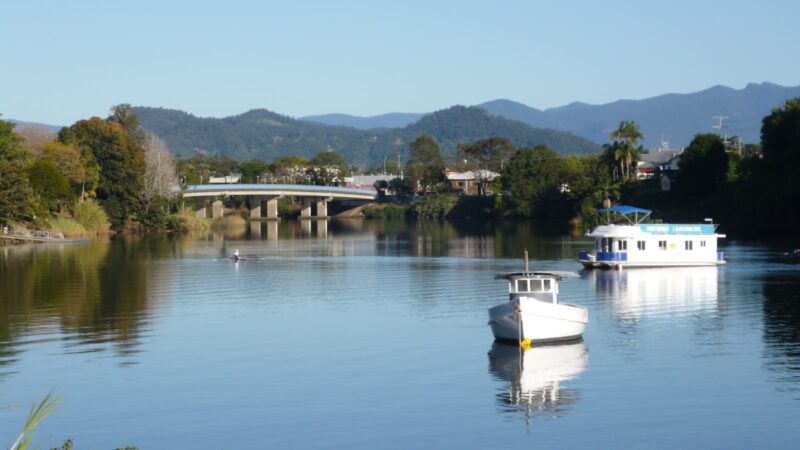Banora Point to Murwillumbah
Ski Lodge Gardens at Barney’s Point, conducted by the Bernoth family, was a busy place in the late sixties and on into the seventies.
Rex Bernoth would patrol the streets of the Twin Towns and beyond, extolling the virtues of the “very, very excellent” water ski exhibition to be seen on the Tweed River two or three time a week.
Brian Shelton and the boys running Coolangatta Tours and Cruises arranged buses to convey holiday makers staying at Beach House; Stella Maris; St. Leonards and Greenmount Guest House to enjoy the hospitality of the Ski Gardens overlooking the Tweed River. Food, drinks and entertainment were the theme of the time, with bookings taken from those keen to test their skills on the water.
At the time, the Pacific Highway passed the front door of Ski Lodge Gardens, found its way over the narrow, low level bridge at Barney’s Point before climbing Sexton’s Hill and on to Tweed Heads/Coolangatta.

By the mid 1990’s the narrow bridge and its approaches had passed their use-by date, and on 19th October 1996 a new bridge was officially opened by a string of politicians, all claiming credit for having made a contribution to the project. Today, a small section of the original bridge remains on the southern side of the River, completely dwarfed by the new bridge, but still a popular fishing spot for visitors and locals alike.
Not far upstream is Stott’s Island, a vivid reminder of the Tweed in days past, of a valley bathed in rainforest trees with an abundance of red cedar, a timber well sought by cabinet makers far and wide. Today, red cedar is in rare supply and much of the Tweed Valley has been cleared and committed to a variety of rural activities such as sugar cane growing.
About 1948 3 new teachers arrived for duty at Murwillumbah High School, as did the writer, fresh from Primary School, just down the road a bit. One such teacher was Bruce Chick, all the way from Mudgee in central western New South Wales. Mr Chick taught English, and it is to his credit that even today I claim to recognise the difference between a noun and an adjective.
A number of years later, Bruce Chick retired from teaching and pursued his second great love: conservation. He left a footprint on the Tweed by planting a large number of native rainforest trees along the bank of the Tweed River, clearly evident as you navigate upstream through the narrow channel between Stott’s Island and Tweed Valley Way.
In the hustle and bustle of today, it is a little difficult to envisage a ferry crossing the Tweed River at Tumbulgum. But indeed it did!! From the early 1800’s right through to December 1986, at which time the current bridge, just downstream from the village of Tumbulgum, was opened, thus bringing to a close a part of the early history of the Tweed Valley. But the old Ferry was not done yet, it was towed out to sea and down to Ulmarra in New South Wales where it provided service on the Clarence River.

Vessels navigating the River needed to be aware of the cables that guided the ferry and stretched from the Tumbulgum Village side to the North Tumbulgum side, just a short distance from where the North Arm of the River enters the main stream.
The ferry operated to a time table well recognised by the locals and if you weren’t there when it was due to leave, a little patience was required as you waited for it to return to your side of the River.
Pat Stephens was the final Ferry master. He was known to our son Mark, who used the Ferry on his way from Terranora to Murwillumbah for work as a mechanic with Mills Transport Company that held the cane haulage contract to the Condong Mill at that time.
In all of my 86 years, I have only lived on flat ground once, and that was in 1990 when transitioning from one house to another at Terranora. We had found temporary rental accommodation at Condong, right next to the sugar mill and experienced 2 floods during the 7 months stay.
During those 2 floods, and undoubtedly many others, the bridge over the Tweed River at Condong, known as Cane Road Bridge, proved a very useful refuge for people like us with cars. Although considered too low for much of the Tweed River traffic, it was well out of flood reach for us! For the cane haulage contractor, the bridge, which was opened in June 1966, provided a much needed shortcut to the mill from areas around the North Arm of the Tweed River.
The original Murwillumbah Bridge was built in the early 1900’s and served Murwillumbah and surrounding areas well until it was replaced with the current structure which was opened for traffic on 26 th October 1968.

In the early months of 1945, after a period of continuous heavy rain, Bill Diamond, who was an executive of Radio Station 2MW, announced that a major flood was imminent and for all necessary preparations to be put in place.
Some of the timber that had been felled in upper areas of the Tweed was not harvested and lay on the forest floor. The 1945 flood gathered much of this timber and sent it down the River to crash into the bridge. Council staff, using long poles pushed many of the logs under the bridge, but some bounced off the bridge, crossed the road near the current roundabout and crashed through the glass shopfront of Tongs grocery store, situated in The Austral building, often coming to rest somewhere down Proudfoot’s Lane between Main and Wollumbin Streets.
The new bridge was built a few metres downstream from the original, is well above flood reach and continues to provide ready access to the busy centre of town.
The staff at Hayes Toyota in Alma Street, South Murwillumbah need little reminder of the power of the River in flood. Indeed a sharp contrast to the tranquil scene of a River at rest!
– Don Piper